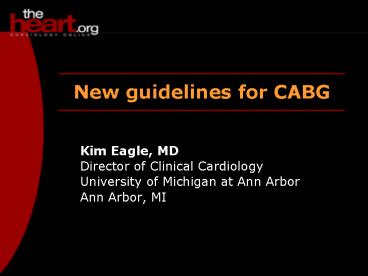Kim Eagle, MD - PowerPoint PPT Presentation
1 / 15
Title:
Kim Eagle, MD
Description:
Medical vs surgical therapy for stable coronary heart disease was re-reviewed. ... Rapidly evolving technology, but questions remain: high learning curve ... – PowerPoint PPT presentation
Number of Views:40
Avg rating:3.0/5.0
Title: Kim Eagle, MD
1
New guidelines for CABG
- Kim Eagle, MD
- Director of Clinical Cardiology
- University of Michigan at Ann Arbor
- Ann Arbor, MI
2
New guidelines for CABG
Why new guidelines?
- The first ACC/AHA guidelines were in 1991.
- All aspects of coronary care have advanced since
then. - Surgical guidelines needed updating.
Kirlin JW, et al. J Am Coll Cardiol
199117543-589
3
New guidelines for CABG
Review of the literature
- Medical vs surgical therapy for stable coronary
heart disease was re-reviewed. - Registry data, and trials comparing angioplasty
vs surgical therapy were also reviewed.
Eagle K, et al. J Am Coll Cardiol
1999341262-1347
4
New guidelines for CABG
General indications for surgery
- Left main coronary artery disease
- 3-vessel coronary disease with any of
- more advanced angina
- reduced resting LV function
- very positive exercise stress test
- 2-vessel disease with very important proximal LAD
stenosis, especially with any of above indicators
5
New guidelines for CABG
Perioperative risk
- A risk tool with a scoring system for the
prediction of perioperative risk is included with
these guidelines. - The tool is based on a logistical regression
model and calculates the risk of - death,
- stroke, and
- deep sternal wound infection.
6
New guidelines for CABG
Focal neurological deficits
- Major strokes are caused by
- emboli from atheromatous plaque in the
ascending aorta - carotid disease
- cardiovascular emboli from the left ventricle
or atrium
7
New guidelines for CABG
Ascending atheromata
- Multiple options in the patient with particularly
mobile atheromata - 1) use a no cross-clamp technique
- (eg, internal mammary graft to LAD
and further percutaneous treatment options
if necessary) - 2) possibility of replacing the aorta with a
graft
8
New guidelines for CABG
Patients at risk
- At risk patients for cardiac sources of emboli
are those with recent anterior-wall MI and
unsuspected atrial fibrillation. - The management and disposition of patients with
carotid disease is also discussed in the
guidelines.
9
New guidelines for CABG
Other issues
- The frequency of myocardial dysfunction after
bypass surgery may be reduced by - the use of the internal mammary artery
- (reduces long-term and perioperative risk)
- the use of blood cardioplegia
- (for acute ischemic or chronically impaired
hearts) - the use of IABP for perioperative support
- antibiotics to
- (reduce perioperative infection)
- prophylaxis against atrial fibrillation
10
New guidelines for CABG
Secondary prevention
- Aggressive control of lipid levels
- (LDLlt130 mg/dL or even lt100 mg/dL)
- Smoking cessation
- Depression and social isolation
- (risk factors for poor outcome)
- Cardiac rehabilitation
11
New guidelines for CABG
Artery vs vein
- Vein grafts are inferior conduits compared to
mammary arteries. - Other arteries fall in-between vein grafts and
the mammary artery. - 3) The data on total arterial bypass is not yet
solid. - The current US standard is IMA to LAD, and vein
graft to other territories.
12
New guidelines for CABG
Using both mammary arteries
- The bilateral use of internal mammary arteries
may lead to a greater risk of deep sternal wound
infection in obese and diabetic patients. - This leads to an unacceptable perioperative
trade-off in mortality. - The use of both mammary arteries is still an area
of active debate.
13
New guidelines for CABG
Minimally invasive CABG
- Rapidly evolving technology, but questions
remain - high learning curve
- insufficient grafts
- limited access to marginal vessels
- Not all patients benefit from the current
technology.
14
New guidelines for CABG
Quality of care
- The new guidelines offer tools for use in day to
day care - risk prediction tool
- guidelines for complication assessment
- incorporate into pre-set orders for
peri-operative care - patient materials
15
New guidelines for CABG
Availability of guidelines
- American College of Cardiology
- http//www.acc.org/clinical/guidelines/bypass/dirI
ndex.htm
Eagle K, et al. J Am Coll Cardiol
1999341262-1347































